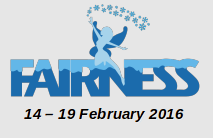Speakers
Mr
Christoph Rosenbaum
(II. Physikalisches Institut, Justus-Liebig-Universität Gießen)
Mr
Stefan Diehl
(II. Physikalisches Institut, Justus-Liebig-University Giessen)
Description
The electromagnetic calorimeter (EMC) of the PANDA detector at the future FAIR facility will be used to study proton - antiproton interaction. The EMC of the target spectrometer with its expected excellent performance and efficiency for electromagnetic probes over a wide energy range from 10 MeV up to 15 GeV, will be one of the central components to achieve the physical goals. The barrel part of the EMC will consist of more than 11,000 lead tungstate (PWO-II) crystals operated at -25°C to achieve the required performance and efficiency.
The contribution will compare the performance of the most recent prototypes of the PANDA barrel EMC. The first large scale prototype PROTO60 consisting of a 6x10 matrix of tapered crystals read-out with a single quadratic LAAPD was tested at various accelerator facilities over the complete envisaged energy range fulfilling the requirements of the TDR of the PANDA EMC in terms of energy, position and time resolution. To realize the final barrel geometry and to test the final front end electronics, a second prototype PROTO120 has been constructed. It represents a larger section of a barrel slice, containing the most tapered crystals and contains the close to final components for the PANDA EMC. The readout is performed with two rectangular large area APDs per crystal, which are read out separately via the specially developed APFEL-ASIC, providing a large dynamic range, low power consumption and optimized signal shaping. The performance of both prototypes will be compared with a focus on the analysis procedure including the signal extraction, noise rejection, calibration and the energy and position resolution. In addition, the influence of the non-uniformity of the crystal on the energy resolution will be discussed.
The project has been supported by BMBF, HIC4FAIR, GSI and EU.
Primary authors
Mr
Christoph Rosenbaum
(II. Physikalisches Institut, Justus-Liebig-Universität Gießen)
Mr
Stefan Diehl
(II. Physikalisches Institut, Justus-Liebig-University Giessen)
Co-authors
Andrea Wilms
(GSI, Darmstadt)
Mr
Andrey Ryazantsev
(IHEP Protvino)
Mr
Hans-Georg Zaunick
(JLU Gießen)
Dr
Myroslav Kavatsyuk
(KVI-CART, University of Groningen)
Dr
Peter Drexler
(II Physikalisches Institut, JLU Giessen)
Dr
Peter Wieczorek
(GSI, Darmstadt)
Mr
Philippe Rosier
(IPN Orsay)
Dr
Rainer Novotny
(Justus-Liebig-Universität Gießen(JULGi))
Mrs
Svetlana Nazarenko
(PhD student in JLU Giessen)
Mr
Till Kuske
(II. Physikalisches Institut, JLU Gießen)
Dr
Valera Dormenev
(II. Physikalisches Institut JLU Giessen)

